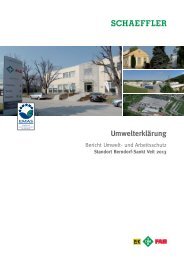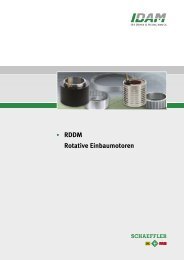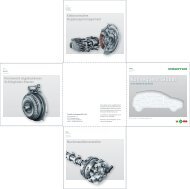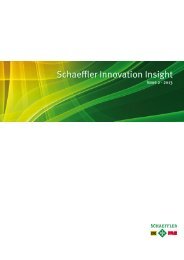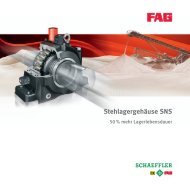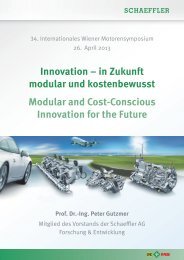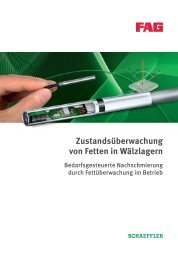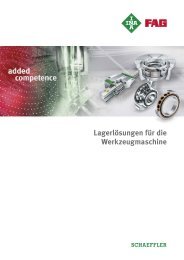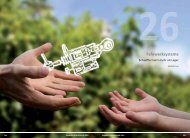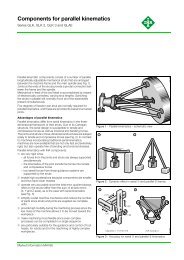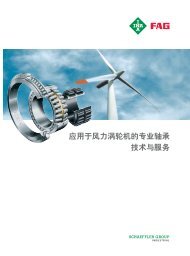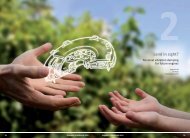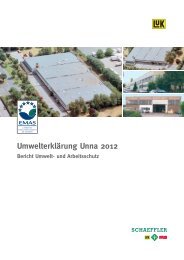Download (PDF, 1.65 MB) - Schaeffler Group
Download (PDF, 1.65 MB) - Schaeffler Group
Download (PDF, 1.65 MB) - Schaeffler Group
You also want an ePaper? Increase the reach of your titles
YUMPU automatically turns print PDFs into web optimized ePapers that Google loves.
28 Reduced fricti on in the drivetrain<br />
28 Reduced fricti on in the drivetrain<br />
Reduced fricti on in the drivetrain<br />
New measures for reducing fricti on<br />
in the drive train<br />
Robert Plank<br />
Dietmar Schwarzenthal, Dr. Ing. h.c. F. Porsche AG<br />
366<br />
Schaeffl er SYMPOSIUM 2010<br />
Schaeffl er SYMPOSIUM 2010<br />
367<br />
28<br />
28
28 Reduced fricti on in the drivetrain<br />
Summary<br />
In a joint advanced development project, Dr. Ing.<br />
h.c. F. Porsche AG and <strong>Schaeffler</strong> KG developed a<br />
CO demonstration vehicle. New optimized com-<br />
2<br />
ponents for the drive train and chassis were incorporated<br />
in this vehicle in order to reduce the<br />
fuel consumption in the New European Driving<br />
Cycle (NEDC) by around 10 % compared with the<br />
current volume produced vehicle. The saving is<br />
split at a ratio of 70 to 30 in the utilization of<br />
technologies with optimized energy requirements<br />
and the reduction of friction on contacts<br />
respectively. The CO demonstration vehicle was<br />
2<br />
created on the basis of a current Porsche Cayenne<br />
with a V8 engine, where <strong>Schaeffler</strong> designed<br />
and verified the individual components<br />
and Porsche was responsible for system adjustments<br />
and validation in the entire vehicle. Each<br />
measure was backed up by calculations and various<br />
experiments, and the overall reduction was<br />
verified in the vehicle model and in vehicle measurements.<br />
Reducing the losses in the engine generated a reducti<br />
on in fuel consumpti on of 5.8 % in the NEDC.<br />
Modifying the valve control VarioCam Plus by<br />
means of electric camshaft phasing and an opti -<br />
mized switchable tappet on the intake side contributed<br />
to 4.1 % of this reducti on. The reduced<br />
fricti on power in the<br />
valve train, belt drive<br />
and chain drive by<br />
Durch in<br />
means of lightweight<br />
components and coated<br />
engine components schneller<br />
reduced the overall<br />
fuel consumpti on a<br />
further 1.7 %.<br />
The tapered roller<br />
bearings in the front<br />
and rear axle fi nal<br />
drive units were replaced<br />
by double row<br />
angular contact ball<br />
bearings thereby reducing<br />
the fuel consumpti<br />
on in the NEDC<br />
by a total of 1.1 %.<br />
Compared with conventi<br />
onal volume pro-<br />
Durch intensive ensive<br />
Zusammenarbeit<br />
Figure 1 The demonstrati on vehicle<br />
duced units, the fricti on power was reduced by<br />
42 % on the rear axle fi nal drive unit and 35 % on<br />
the front axle fi nal drive unit.<br />
Using wheel bearings with opti mized fricti on characteristi<br />
cs and replacing the hydraulic roll stabilizer<br />
with an electric roll stabilizer reduced fuel consumpti<br />
on in the NEDC by 3.2 %. The reducti ons on<br />
the rolling test stand are already generated when<br />
traveling straight ahead by eliminati ng the drive<br />
power of the hydraulic pump, so that even higher<br />
savings can be expected during measurements in<br />
more customer-oriented vehicle tests on winding<br />
roads.<br />
Further opti mizati ons to the chassis and drive train<br />
of the demonstrati on vehicle that were not previously<br />
included in the measurements will be carried<br />
out during the next few months.<br />
Collaborati on<br />
between Schaeffl er<br />
and Porsche<br />
Today, engineers of both companies are working<br />
closely on assessing and implementi ng ideas for<br />
developing new components while taking all the<br />
von on der Idee<br />
zum um serienreif serienreifen en Produk Produkt<br />
appropriate steps right<br />
from the start. This is<br />
because this is the<br />
only means of taking<br />
on the challenge of a<br />
future that categorically<br />
and quickly requires<br />
lower contaminant<br />
emissions, lower<br />
CO 2 output and lower<br />
fuel consumpti on. This<br />
arti cle shows that this<br />
strategy can lead to<br />
very unconventi onal<br />
soluti ons. However, it<br />
cannot be overlooked<br />
in this very special<br />
case that progress can<br />
only be made in small<br />
steps in such a young<br />
and modern vehicle<br />
such as the Porsche<br />
Electromechanical variable<br />
camshaft timing of intake<br />
and outlet side<br />
Cayenne. Lowering the fuel consumpti on by<br />
around 10 % is the result of several, in some cases<br />
far-reaching, measures.<br />
Together, these two companies carried out advance<br />
development on new components that<br />
were tested in a demonstration vehicle based<br />
on the current Porsche Cayenne. The demonstration<br />
vehicle is easily recognizable since it<br />
features the “Co 2 ncept-10 %” logo as well as<br />
pictures of the various new components it contains.<br />
High-tech valve<br />
ti ming adjustment<br />
– electric camshaft<br />
phasing and<br />
opti mized valve lift<br />
acti vati on<br />
The first step of the task was to demonstrate<br />
how the fuel consumption and CO 2 emissions<br />
can be reduced in a V8 engine from a Porsche<br />
Cayenne by optimizing the already very success-<br />
Reduced fricti on in the drivetrain<br />
ful VarioCam Plus system. To do so, engineers at<br />
<strong>Schaeffler</strong> and Porsche replaced the hydraulic<br />
camshaft phasing system in volume production<br />
with an electric system. This solution involves<br />
very compact electric motors that adjust the<br />
timing of the valves on the intake and exhaust<br />
camshafts. The high torque required for this is<br />
due to the high power transmission ratio of the<br />
small electric motor that can reduce the speed<br />
by a ratio of 66:1 and, at the same time, increase<br />
the torque of the electric motor by the same ratio.<br />
The electric system has two advantages compared<br />
with the conventional hydraulic solution:<br />
• Less energy is required since the motors only<br />
operate when adjusti ng the valve ti ming is<br />
necessary. There are theoreti cally speaking also<br />
no longer any limits to the ti ming angle. In<br />
practi ce, this means that a larger ti ming angle<br />
can be used,<br />
• as well as faster adjustment.<br />
Both these improvements not only lower fuel consumpti<br />
on, the engine performance characteristi c<br />
of the engine is also improved.<br />
Along with the valve ti mings, the valve lift on the<br />
intake side plays a decisive role in the energy-saving<br />
plans of our engineers. The lift is adjusted by<br />
electro-hydraulic valve tappets. This eff ect that re-<br />
368 Schaeffl er SYMPOSIUM 2010<br />
Schaeffl er SYMPOSIUM 2010 369<br />
VValv alvee lift lift<br />
Cr Crank ank angle<br />
Figure 2 Opti mized VarioCam Plus system<br />
Switchable tappet with<br />
improved shifting<br />
performance<br />
Asymmetric valve lift<br />
for charge movement<br />
28<br />
28
28 Reduced fricti on in the drivetrain<br />
duces both fuel consumpti on and emissions is generated<br />
by two variable values:<br />
• Less valve lift and shorter opening ti mes reduce<br />
the charge-exchange losses in the parti al load<br />
range and increase the speed of the incoming air<br />
for more eff ecti ve mixture preparati on.<br />
• Furthermore, the system facilitates the deacti vati on<br />
of the intake port (to generate high charge<br />
movement) when the engine is operati ng in the<br />
lower parti al load range and varies the level at<br />
which both intake valves of each cylinder are<br />
opened when the engine is operati ng in the higher<br />
parti al load range.<br />
These ingenious measures trigger a small “whirlwind”<br />
in each combusti on chamber that permits<br />
the creati on of an especially homogenous and ignitable<br />
gasoline-air mixture that ensures very effi -<br />
cient combusti on cycles even at low loads.<br />
The improvement generated by the opti mized VarioCam<br />
Plus system lies in the parti al load range<br />
(Figure 3). According to current results, adjusti ng<br />
the valve ti ming, valve lift and charge movement<br />
lower the fuel consumpti on calculated for the<br />
NEDC by 4.1 %.<br />
A very informati ve diagram (Figure 4) shows the<br />
possible new designs for the valve tappet of the<br />
future. For example, the valve tappet of the future<br />
may no longer be round and similar to a cup, but<br />
may be shaped in such a way so that it only has<br />
Change of weight in %<br />
+50<br />
+25<br />
-25<br />
-50<br />
-70<br />
EEff ffectiv ectivepr e pressur essuree<br />
Fuel consump consumption<br />
tion reduction of VarioCam Plus in<br />
comparison omparison toV to<br />
VarioCam arioCam Plus optimiz optimized<br />
ed<br />
-2 -2%<br />
0%<br />
-5 -5%<br />
-10 -10%<br />
Shifting level le el<br />
lo low/high w/high valv valvee<br />
lift<br />
Engine speed<br />
Figure 3 Improving fuel consumpti on in the<br />
characteristi c diagram with the opti mized<br />
VarioCam Plus system<br />
contact surfaces for the tappet where a certain<br />
functi on is fulfi lled.<br />
Lowered fricti on<br />
power in the internal<br />
drive systems of<br />
the engine<br />
The diameter of tappets has significantly reduced<br />
during the last decade and the new design<br />
has enabled us to reduce the moving mass to<br />
Heat treatment Coating technology Surface topographie<br />
Case hardening Carbonitrinding Triondur C+ Lateral grinding<br />
D=35<br />
Conventional bucket tappet<br />
1990 1995 2000 2005 2010<br />
Figure 4 Measures for the valve train<br />
D=33<br />
D=33<br />
Year<br />
D=28<br />
Switchable tappet<br />
D=31<br />
D=31<br />
D=28<br />
0 2000 4000 6000<br />
Figure 5<br />
Engine speed in 1/min<br />
Reducti on in driving torque due to measures<br />
on the valve train<br />
only 30 %. For optimum smooth running, the<br />
cast camshafts and the tappets they actuate undergo<br />
intensive surface treatment. After intense<br />
development, the contact surfaces of these<br />
parts are now coated with TriondurC+, a DLC<br />
coating system that is around 3 μm thick and has<br />
a hardness of up to 3000 HV, which can significantly<br />
reduce friction<br />
and offers an extremely<br />
high resistance<br />
to wear. Furthermore,<br />
the valves<br />
of the V8 engine of<br />
the future could be<br />
significantly lighter,<br />
despite not being any<br />
smaller in size.<br />
This general reduction<br />
in moving masses not<br />
only promotes the<br />
running smoothness<br />
and lively revving abil-<br />
Reduced fricti on in the drivetrain<br />
ity of the engine, but also curbs the fuel consumption.<br />
Here too, the fricti onal torques were clearly lowered<br />
by more than 20 %.<br />
Using similar fi ne tuning, our engineers also lowered<br />
the required drive power for the chain drive<br />
that operates the four camshaft s. Chain tensioners<br />
opti mally adjusted to the drive and coati ng the<br />
chain sprockets also lower the fricti on.<br />
The forces in the primary drive can be lowered by<br />
around 25 % if all changes to the primary drive and<br />
valve train are made simultaneously.<br />
The V-belt drive on the front of engines has become<br />
more complex during development, since<br />
the desire for improvement and comfort has increased<br />
the number of units to be driven. This results<br />
in increasing power expenditure that has to<br />
be compensated with targeted measures.<br />
Porsche and Schaeffl er have taken on this challenge<br />
and have found the soluti on for reducing<br />
losses in the presented project with a series of<br />
370 Schaeffl er SYMPOSIUM 2010<br />
Schaeffl er SYMPOSIUM 2010 371<br />
Crankshaft torque<br />
Driving torque of valve train on<br />
dragged cylinder head at T - 90 °C)<br />
Öl<br />
Improved<br />
chain tensioner<br />
-20 %<br />
Measures<br />
valve train<br />
Figure 6 Measures in the primary drive<br />
Before op�miza�on<br />
A�er op�miza�on<br />
Coated<br />
sprocket wheel<br />
Double sided multi-V rib<br />
with 6 instead of 7 ribs<br />
Alternator overrunning<br />
pulley<br />
Force<br />
Figure 8 Measures in the ancillary drive<br />
Measurement of chain load of driving side<br />
at a dummy test rig<br />
-25 %<br />
Before op�miza�on<br />
A�er op�miza�on<br />
Engine speed<br />
Figure 7 Reducing forces in the primary drive<br />
Improved<br />
belt tensioning unit<br />
Idler pulley with<br />
one guiding rib<br />
28<br />
28
28 Reduced fricti on in the drivetrain<br />
Fuel consumption measurements NEDC NEDC belt drive measurements<br />
Consumption NEDC<br />
Potential depending on application and<br />
current of the generator<br />
Without<br />
alternator<br />
overrunning pulley<br />
-0,3 %<br />
With<br />
alternator<br />
overrunning pulley<br />
measures. More eff ecti ve chain tensioners and<br />
the use of a narrower belt (six ribs instead of seven)<br />
facilitate the smooth transmission of power.<br />
Even the drive force requirements of the idler pulleys<br />
were reduced by limiti ng the roller to one<br />
guide profi le.<br />
A further important role is played by the overrunning<br />
alternator pulley in the eff orts to lower the<br />
required power for the belt drive. This is because<br />
it enables the generator to keep a near constant<br />
speed, despite irregular sti mulati on from the<br />
crank drive and valve train. The more constant<br />
speed of the generator reduces the dynamic forces<br />
in the belt drive and therefore the fricti on and<br />
power loss in the system. However, the potenti al<br />
for reducing losses is heavily dependent on the<br />
relevant applicati on and on the actual charging<br />
current of the generator, since high performance<br />
delivery produces a high braking torque in the<br />
generator. This, in turn, infl uences the dynamics<br />
in the belt drive.<br />
The diagram clearly shows the level of fl uctuati<br />
ons in speed in the drive and therefore the forces<br />
in the belt drive of the generator in city traffi c<br />
without an overrunning alternator pulley. The<br />
mean of several very precise measurements taken<br />
in the NEDC when using an overrunning alternator<br />
pulley is a 0.3 % reducti on in fuel consump-<br />
Significant reduction<br />
of dynamic forces<br />
Without alternator overrunning pulley<br />
With alternator overrunning pulley<br />
Engine speed<br />
Force<br />
Time<br />
ti on. In additi on, reducing the load placed on the<br />
belt by means of the pulley can increase the life of<br />
the V-belt.<br />
Measures on the<br />
front axle and rear<br />
axle fi nal drive units<br />
and wheel hubs<br />
With its INA and FAG brands, the Schaeffl er <strong>Group</strong><br />
is one of the world’s leading experts in rolling<br />
bearing technology. This is also one of the reasons<br />
why the Schaeffl er <strong>Group</strong> is a perfect development<br />
partner for Porsche when it comes to<br />
smooth running in vehicles. Schaeffl er then also<br />
pointed out that fricti on losses in the fi nal drive<br />
units on the front and rear axles can also be signifi<br />
cantly reduced.<br />
The recommended measures involve replacing<br />
the traditional tapered roller bearings on the<br />
universal shaft drive side with tandem ball bearings<br />
and more efficient single-row ball bearings<br />
on the left and right sides of the differential<br />
housing for driving the axle shafts.<br />
Figure 10 Measures on the front and rear fi nal drives<br />
Figure 9 Improving fuel consumpti on and reducing forces by means of overrunning alternator pulleys -42 %<br />
Reduced fricti on in the drivetrain<br />
The results are remarkable. The power loss on<br />
the front axle is reduced by 35 %. This increases<br />
to 42 % on the rear axle due to the increased<br />
load.<br />
The Porsche Schaeffl er project also generated<br />
more improvements and smooth running in the<br />
wheel bearings.<br />
In this case, improvements were made due to the<br />
opti mized preload of the double-row ball bearings<br />
and by redesigning the seal system including the<br />
outer seal. Together with a minimized bearing preload,<br />
the omission of garter spring load by means<br />
of a modern seal without steel springs as well as<br />
reducing the sealing interference led to a 30 % re-<br />
372 Schaeffl er SYMPOSIUM 2010<br />
Schaeffl er SYMPOSIUM 2010 373<br />
Power loss<br />
Power loss in the NECD measurement<br />
Angular contact ball bearing<br />
Tapered roller<br />
bearing<br />
Time<br />
Figure 11 Reducing power loss by means of an<br />
opti mized rear axle fi nal drive unit<br />
Outside seal system<br />
ECO-cardridge<br />
(2 seal lips without<br />
garter spring load)<br />
Figure 12 Measures for wheel bearings<br />
Optimized<br />
bearing preload<br />
Replacement of tapered roller<br />
bearing by angular contact<br />
ball bearing<br />
Speed<br />
-30 %<br />
Drive torque Results of measurements on component test rig<br />
Before<br />
optimization<br />
After<br />
optimization<br />
Figure 13 Reducti on of torque loss with opti mized<br />
wheel bearings<br />
28<br />
28
28 Reduced fricti on in the drivetrain<br />
ducti on of fricti on losses with constant sealing acti<br />
on.<br />
Overall, the potenti al for reducing fuel consumpti<br />
on is far below 1 %. Despite this fact, the energy<br />
effi ciency is generated by the sum of all individual<br />
measures and the opti mizati on of individual potenti<br />
al that seems low at fi rst glance is also worthwhile.<br />
Electrically<br />
adjustable roll<br />
stabilizers<br />
The requirements placed on a sporty SUV such as<br />
the Porsche Cayenne are extremely varied. In road<br />
traffi c, the vehicle must master bends in the road<br />
without roll movement. Off road, this “taming” is<br />
not desired: Severe axle arti culati on ensures contact<br />
with the ground and tracti on. Up to now,<br />
Porsche has met this challenge with an acti ve hydraulic<br />
control system for the stabilizers on both<br />
axles. However, due to the permanent supply of oil<br />
to the hydraulic pump, this soluti on requires permanent<br />
operati on of the pump and therefore leads<br />
to permanent losses.<br />
Experience has shown that some hydraulic systems<br />
can be effi ciently replaced by electric sys-<br />
Fuel consump�on NEDC<br />
Calculated fuel consump�on<br />
reduc�on NEDC<br />
-3 %<br />
Average actua�on power<br />
of an�-rollsystem<br />
Hydraulic Electromechanical<br />
Hydraulic<br />
Replacement of hydraulic an�-roll system<br />
by electromechanical an�-roll system<br />
Hydraulic an�-roll system<br />
Electromechanical an�-roll system<br />
Figure 14 Measures for roll stabilizati on<br />
tems. This knowledge generated a soluti on that<br />
sets the required stabilizer torques as needed.<br />
During this process, the electric motor only requires<br />
power when the pivot actuator turns and<br />
thereby generates torque. When maintaining<br />
torques, only the relati vely low electric resistance<br />
losses must be compensated for. The roll stabilizati<br />
on system is relati vely inacti ve on a freshly laid<br />
motorway, but has to be considerably more acti ve<br />
on a normal road de-<br />
Average actua�on power on spor�ve<br />
winding roads<br />
-80 %<br />
Electromechanical<br />
Figure 15 Reducing fuel consumpti on and drive power by means of opti mized roll<br />
stabilizati on<br />
pending on the conditi<br />
on of the road, the<br />
number of bends, and<br />
the driver’s driving<br />
style. This is why the<br />
electromechanical roll<br />
stabilizing system has<br />
an extremely large<br />
potenti al for savings<br />
compared with the uncontrolled<br />
hydraulic<br />
system where the supply<br />
of oil to the pump<br />
is constant.<br />
Adjusti ng the roll stabilizers<br />
using the electrical<br />
system lowers the<br />
consumpti on in the<br />
NEDC by 3 %.<br />
Taking stock of fuel<br />
consumpti on and<br />
emissions:<br />
10 % reducti on<br />
Figure 16 shows the simulation model and the<br />
variety of factors that facilitate a reduction in<br />
fuel consumption. Before implementation, all<br />
measures were evaluated in prototypes and during<br />
experiments regarding their contribution to<br />
lowering fuel consumption using calculations in<br />
a vehicle model. Specific simulation models for<br />
individual road resistances are shown in the rel-<br />
Engine and<br />
accessor accessoryy driv drive<br />
Reduced fricti on in the drivetrain<br />
evant functional blocks along the drive train.<br />
During the project, the advance development<br />
tasks for the components were split between<br />
<strong>Schaeffler</strong> and Porsche, which meant that data<br />
and characteristic diagrams were determined on<br />
component test stands at <strong>Schaeffler</strong>, on fired engine<br />
test stands at Porsche and in vehicle tests<br />
that provided a physical representation of the<br />
function behavior of the components. This data<br />
was used to adjust the simulation program during<br />
the early stages of development, which made<br />
it possible to make statements about the influence<br />
of each measure on fuel consumption.<br />
More detail was given to these statements during<br />
further steps of development.<br />
The overall savings realized on an existing volume<br />
production vehicle are currently around<br />
10 % when all measures<br />
are considered<br />
together. However,<br />
this is not the end of<br />
the line. Porsche and<br />
<strong>Schaeffler</strong> are using<br />
their growing experience<br />
to reduce fuel<br />
consumption even<br />
further. 70 % of the<br />
improvements made<br />
so far involve technology<br />
with optimized<br />
energy requirements<br />
and 30 % involve reducing<br />
friction in the<br />
drive systems.<br />
374 Schaeffl er SYMPOSIUM 2010<br />
Schaeffl er SYMPOSIUM 2010 375<br />
Cockpit,<br />
Driver<br />
Gear control<br />
Figure 16 Simulati on model for NEDC calculati on<br />
Fuel consumption influence NEDC<br />
100 %<br />
90 %<br />
80 %<br />
70 %<br />
60 %<br />
50 %<br />
Cayenne S Electr.<br />
anti-roll<br />
system<br />
(optional<br />
equipment)<br />
Figure 17 Results of NEDC calculati on<br />
Automatic transmission<br />
and distribution gearbox<br />
Optimized<br />
wheel<br />
bearing<br />
Wheels,<br />
tire<br />
and brake<br />
Optimized<br />
VarioCam Plus<br />
Axle gearbox<br />
and differential<br />
gearbox<br />
-3.0% -0.2% -4.1% -1.7% -1.1%<br />
Reduction<br />
of<br />
engine<br />
friction<br />
Friction<br />
optimized<br />
front/rear<br />
axle gearbox<br />
CO2<br />
Demonstrator<br />
28<br />
28
28 Reduced fricti on in the drivetrain<br />
The calculati ons made on the basis of measurements<br />
taken on test stands show that fuel consumpti<br />
on and consequently CO 2 emissions could<br />
be reduced a further 10 % at the current stage of<br />
advance development. Here, opti mized valve control<br />
has the lion’s share. It is also worth noti ng that<br />
the 3 % saving generated by the electrically controlled<br />
roll stabilizer will probably be even higher<br />
during normal day-to-day operati on that deviates<br />
from standardized test stand cycles. The countereffects<br />
of the measures with each other can infl uence<br />
the potenti al of single measures to reduce<br />
fuel consumpti on.<br />
Figure 18 Measurements taken with the vehicle on the rolling test stand<br />
Roll out test comparison with/without<br />
op�mized rear axle gearbox<br />
Roll out time<br />
+ 2,5 %<br />
With op�mized<br />
rear axle gearbox<br />
Without op�mized<br />
rear axle gearbox<br />
0 20 40 60 80 100 120<br />
Roll out speed<br />
Figure 19 Results of measurements on the vehicle<br />
In additi on, Porsche and Schaeffl er will work intensively<br />
on successfully tapping further potenti al<br />
thereby reducing fuel consumpti on and CO 2 emissions.<br />
Safeguarding a reducti<br />
on in fuel consumpti<br />
on during<br />
vehicle tests<br />
The next step involved<br />
fi tti ng the various components<br />
in a demonstrati<br />
on vehicle. Measurements<br />
on the road<br />
and on a rolling test<br />
stand were made with<br />
this vehicle to confi rm<br />
the calculated potenti al<br />
of the measures for cutti<br />
ng fuel consumpti on.<br />
In order to evaluate the<br />
benefi t in relati on to<br />
the outlay, it is important<br />
to verify the potenti<br />
al of each measure<br />
in the vehicle itself. As<br />
Calculated fuel consump�on reduc�on NEDC<br />
Consump�on NEDC<br />
Before<br />
op�miza�on<br />
- 1 %<br />
A�er<br />
op�miza�on<br />
menti oned above, the bearings in the front and<br />
rear axle fi nal drives were replaced with opti mized<br />
bearings. The individual potenti al of these bearings<br />
was determined in coast down tests with volume<br />
producti on fi nal drive units and modifi ed fi nal<br />
drive units on a rolling test stand.<br />
During these tests, the vehicle coasts down from a<br />
starti ng speed of 120 h/km to 5 h/km. A comparison<br />
between the opti mized rear axle fi nal drive unit and<br />
the volume produced unit shows that the coasti ng<br />
ti me is 2.5 % longer. Adjusti ng the rear axle fi nal<br />
drive unit road resistance functi onal block of the<br />
simulati on model using this result leads to a calculated<br />
improvement in fuel consumpti on in the NEDC<br />
of around 1 %. This means that it was possible to<br />
confi rm the total reducti on in fuel consumpti on of<br />
1.1 % for front and rear axle fi nal drive units previously<br />
ascertained from component tests.<br />
Conclusion<br />
Reduced fricti on in the drivetrain<br />
Taking stock of this joint project between Porsche<br />
and Schaeffl er using the Cayenne opens up a wide<br />
range of possibiliti es for the future. The combinati<br />
on of the measures illustrated for minimizing<br />
losses shows that it is possible to reduce the fuel<br />
consumpti on of a conventi onal drive with a gasoline<br />
engine in a two-digit percent range without<br />
hybridizati on. The soluti ons presented are not limited<br />
to SUVs and can be transferred to other types<br />
of vehicles and drives.<br />
Individual improvements such as the more smoothrunning<br />
rolling bearings can easily be transferred<br />
to volume producti on. Other components must<br />
undergo a cost benefi t analysis to show whether<br />
volume producti on development can begin.<br />
376 Schaeffl er SYMPOSIUM 2010<br />
Schaeffl er SYMPOSIUM 2010 377<br />
28<br />
28




